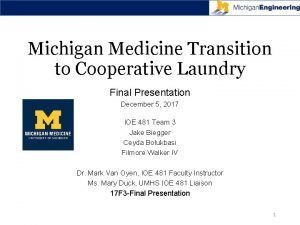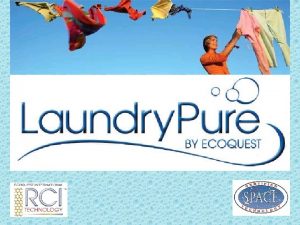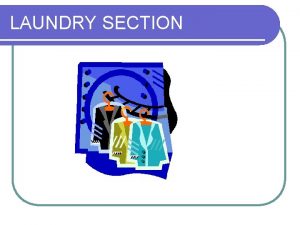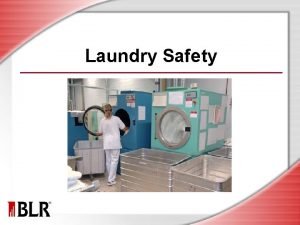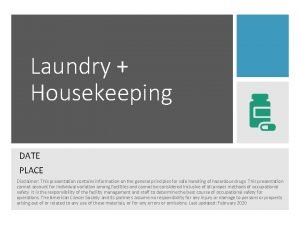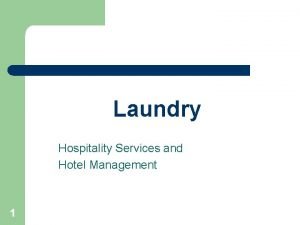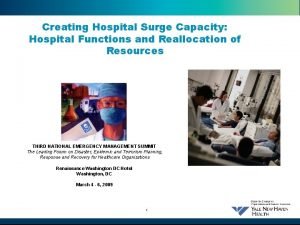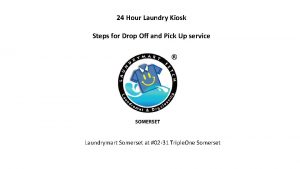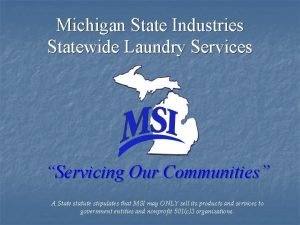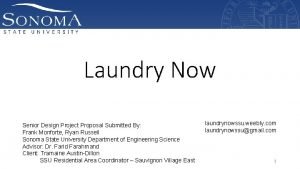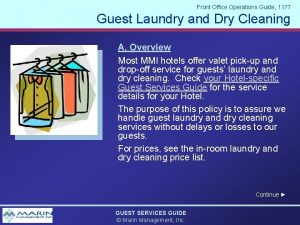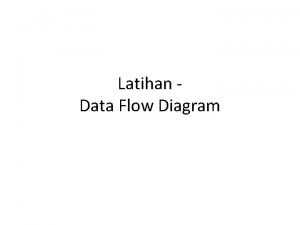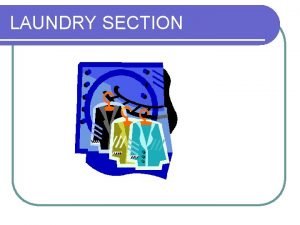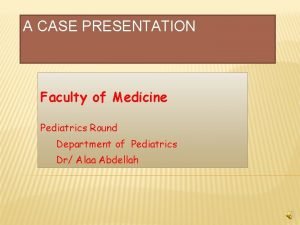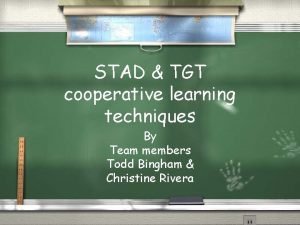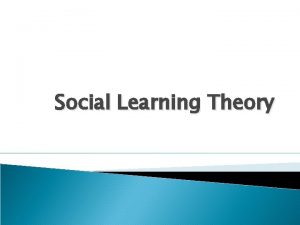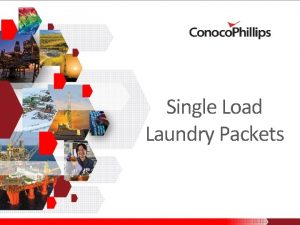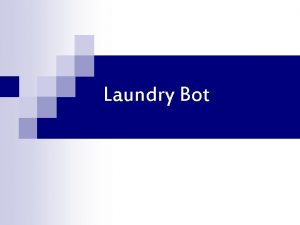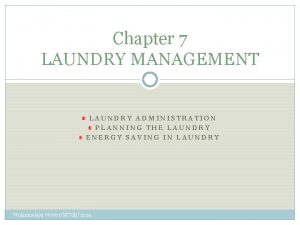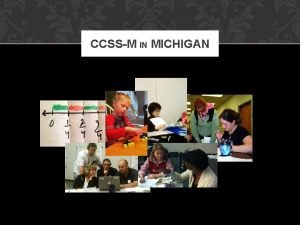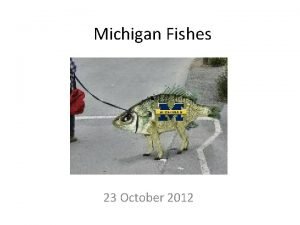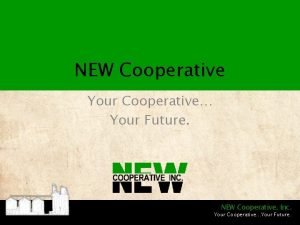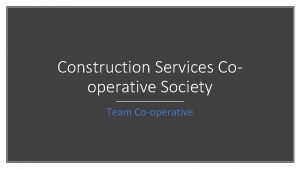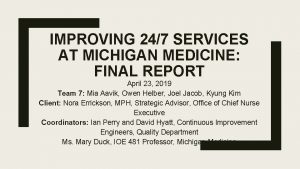Michigan Medicine Transition to Cooperative Laundry Final Presentation



































- Slides: 35

Michigan Medicine Transition to Cooperative Laundry Final Presentation December 5, 2017 IOE 481 Team 3 Jake Biegger Ceyda Bolukbasi Filmore Walker IV Dr. Mark Van Oyen, IOE 481 Faculty Instructor Ms. Mary Duck, UMHS IOE 481 Liaison 17 F 3 -Final Presentation 1

Introduction & Background • UM operates its own laundry system • Operation will transition to a COOP in 18 – 24 months UM laundry facility Ann Arbor, MI COOP laundry facility Detroit, MI • Future state improvement opportunities Transportation Storage Delivery Benchmark analysis 2

Changes in Current vs. Future State Current Future Transport dirty laundry from hospitals to facility Transport dirty laundry from hospitals to depot Clean laundry Transport dirty laundry to COOP Clean laundry Deliver clean laundry Transport clean laundry to depot Distribute laundry in hospitals Distribute laundry in Hospitals 3

Key Issues 1. 2. Shift to the COOP will alter laundry process by removing the production aspect New COOP allows for opportunity for distribution and delivery redesigns 4. 3. Total number of unique linen items too high to conform with the COOP capabilities Necessary locations and size of storage depot unknown 4

Goals & Objectives To determine most effective way to transition to COOP: Resulting recommendations: • Analyze the current transportation, distribution, and storage processes • Process improvements for future state • Benchmark other COOPs and hospitals for comparison • Assess potential service impacts to Michigan Medicine • Best system for storage and transportation • Potential benefits and risks with transition to COOP • Timeline for implementation of recommendations 5

Scope In Scope • Distribution and delivery steps of laundry process Out of Scope • Production aspect of delivery process • 5 main UM hospitals • Benchmark Analysis • Offsite locations • Measurements: • Overall linen usage • Projected future demand • In-house deliveries • Ambulatory care unit (ACU) deliveries 6

External Laundry Delivery Process Internal Linen Distribution Benchmarking Literature Search Methods and Data Collection Findings and Conclusions Recommendations 7

External Laundry Delivery Process Observation and Interviews Observed 3 deliveries over 5 hours • Number of robos delivered • Recorded truck utilization • Performed Time studies • Route Time Historical Data Item quantity per robo Year-to-Date Data • Driver Logs • Daily Laundry Delivered to each hospital • Total Delivery Time October 17, 2017 8

Internal Linen Distribution Operations Observation and Interviews Observed two 4 -hr hospital shifts • Shadowed various hospital workers on routes • Interviewed workers on current process • Received data about inventory shortages October 19, 2017 Time Studies Created form for workers to self-collect times to: • Pack cart • Walk from holding room to first clean room • Unload linen in clean rooms • Count inventory needs • Walk from last clean room to holding room • Redistribute unused linen November 20 & 28, 2017 9

Benchmarking Analysis Literature Research: • • • Advantages of using a COOP General standards Common methods used Benchmarking Literature Research On-site Visit On-site hospital visit: • U of M Hospital • St. Joseph Mercy Health System in Ann Arbor Functional Benchmarking: 3 major COOPs • MI Premier Laundry (MPL) • West MI Shared Laundry • North Grand River Cooperative 2 hospitals in Michigan • St. Joseph Mercy Health System • St. John Providence 14 hospitals from prior benchmarking analysis 10

External Laundry Delivery Process Internal Linen Distribution Benchmarking Literature Search Methods and Data Collection Findings and Conclusions Recommendations 11

Historical Daily Demand *Demands are in number of robos of laundry Jan Feb Mar Apr May Jun Jul Aug Sep Oct UH 48. 0 44. 8 43. 8 45. 6 47. 6 43. 4 45. 3 45. 8 48. 2 45. 6 CW 21. 4 18. 2 21. 4 20. 5 20. 0 19. 8 20. 6 19. 8 21. 2 Total 69. 4 63. 0 65. 2 66. 0 68. 1 63. 4 65. 1 66. 4 68. 0 66. 8 12

Forecasting – Holt’s Method Parameters Level Equation Trend Equation Forecast Equation 13

Forecast Findings 2017 Avg (Robos) Dec-19 (Robos) % Increase 25% Increase (Robos) UH 45. 8 48. 2 5. 2% 57. 3 CW 20. 4 22. 6 10. 7% 25. 5 Total 66. 2 70. 8 6. 9% 82. 8 Long Term Demand Increase (5+ years) 14

Simulation Design Stat Fit Weekday daily demand of laundry Entities 5 most demanded laundry items “Other” - remaining laundry items Full Robos Truck Macros Robo Capacity Truck Capacity Demand Factor Demand is met Assumptions COOP container size and truck capacity Incr/Decr to capacity is consistent over all items 15

Deliveries greatly exceed Scenario 1 Simulation Findings Scenario Demand_Factor Scenario Robo_Capacity_Factor 1 2 5 2 1. 25 4 1. 00 1 1. 07 18. 00 1. 07 22. 00 1. 25 18. 00 1. 25 22. 00 Robo_Capacity_Factor UH Deliveries 3. 00 1 3. 05 1 0. 8 3. 15 1 3. 40 0. 8 3. 45 CW Deliveries Truck_Capacity 1. 65 18 1. 6518 1. 75 22 1. 85 18 22 1. 85 1. 00 18. 00 1. 07 4 1. 07 3 0. 80 Demand_Factor Truck_Capacity 1. 00 3 1 1. 00 1. 25 5 0. 80 UH Containers 44. 70 45. 70 57. 55 53. 80 66. 90 CW Containers 20. 20 25. 50 23. 90 29. 80 16

Parameters Needed for Schedule Simulation Findings Scenario 6 7 8 Demand_Factor 1. 25 1. 07 Robo_Capacity_Factor 1. 15 1. 00 0. 85 18. 00 22. 00 UH Deliveries 3. 00 2. 95 CW Deliveries 1. 65 1. 60 UH Containers 44. 70 53. 80 CW Containers 20. 20 23. 90 Truck_Capacity 17

Distribution Current State Process Laundry leaves laundry facility Laundry arrives at unloading docks (UHS / CS Mott) Laundry unloaded from truck by driver and hospital workers Laundry placed in respective holding rooms Stock keeper walks to each clean room Stock keeper counts and records inventory levels Stock keeper walks back to holding room Stock keeper picks necessary inventory in holding room Most employees neglect this aspect Return to collect more inventory Stock keeper wheels laundry to clean rooms Shortage No Return cart Linen left after distribution? Stock keeper distributes laundry accordingly Yes Return inventory to shelves in stock keeper room Return cart 18

Current State Process Time Breakdown Total Process Time: 73. 26 minutes Improvement focus Pack Cart Walk to First Unload Linen at Clean Room Count Inventory Walk back to Restock Holding Room Unused Linen 19

Opportunities for Improvement • No standard work • Lack of technology 20

Benchmarking Analysis • Received responses from: • Michigan Premier Laundry (MPL) • North Grand River Cooperative (NGRC) • University of Wisconsin Health • University of Washington • St. Joseph Mercy Health System - Ann Arbor • Visited St. Joseph Mercy Health System on-site 21

Benchmarking COOPs • Michigan Premier Laundry (MPL) Administrative Manager 23 million pounds/ year 100 -mile radius Utilizes Linen Master Limited delivery interruptions Process Cycle -Standard linen list -Unique items are processed at a higher rate Purchasing Processing MPL controls hospital inventory -> hospitals have no safety stock Picking up soil laundry Biggest advantages of COOPs “Cost savings in linen purchases, lower utility and labor costs” Delivering -Monday - Friday -No storage for processed linen (keeps dock empty to hold carts) 22

Benchmarking COOPs • North Grand River Cooperative (NGRC) General Manager 9 million pounds/ year Linen processing 45 -mile radius Linen distribution through exchange carts or as bulk Pooled Linen System: -72 - 96 -hr supply of circulating inventory on-hand -All in first out -Standardized method, not customized for different hospitals Utilizes Linen Master COOP has trucks that make one stop deliveries, up to 15 stops daily Emergency action plan – 30 min -Set start times for each route -Multiple deliveries per day, M-WF deliveries, call-in orders -Largest deliveries scheduled for first runs -Stores linen on-site Biggest advantages of COOPs “Lower costs is the biggest benefit…can get discounts for economy of scale purchasing, shared replacement cost for equipment and facility needs” 23

Benchmarking Hospitals • University of Wisconsin Health Director of Materials Management 14 million • pounds/ year Less than 10 miles away 5, 000 square footage storage Utilizes People. Soft COOP : Madison United Healthcare Linen (MUHL) has 130 SKU (stock keeping units) utilizes Linen. Master Delivery Schedule: more than 5 times per day (6 am till 3: 30 pm) • University of Washington Program Operations Manager 14. 3 million pounds/ year Less than 10 miles away Minimal safety stock (2 -3 days) Biggest issue: Space COOP : UW Consolidated Laundry has 200 unique linen items Software: Linen. Master, Linen. Helper, and Spindle for production & Bigfoot for maintenance Delivery Schedule: 4: 30 am till 5 pm 24

Benchmarking Hospitals • St. Joseph Mercy Interim Manager of Hospital Transportation and Linen Service 4 million • pounds/ year 40 -50 mile radius No safety stock Robots (AGV) and air chutes -Delivered via 2 trucks daily, each having 22 wired carts -Hospital’s 2 trucks = overnight storage -Dead linen issue (unusable vs. soiled) -Elevator design -Packer responsibilities -No item counting -past: Yellow Dog inventory software 25

External Laundry Delivery Process Internal Linen Distribution Benchmarking Literature Search Methods and Data Collection Findings and Conclusions Recommendations 26

External Delivery Process 7% Forecasted Increase Safety Stock (Clean Laundry) Minimum Capacity (Clean Laundry) 25% Long Term Increase 1 day 71 robos 663 ft 2 1 day 83 robos 774 ft 2 3 days 213 robos 1988 ft 2 3 days 249 robos 2324 ft 2 Maintain Current Delivery Schedule Container Capacity (Relative to Robo) Truck Capacity 1. 00 0. 85 1. 15 1. 00 18 22 27

Internal Future State Process Flow Laundry leaves laundry facility Laundry arrives at unloading docks (UHS / CS Mott) Single employee measures inventory level with scanner • Standardized process • Eliminates need for each worker to count inventory each trip • ½ as many trips during a given process cycle • Majority of workers will use scanners less • Team-based system Laundry unloaded from truck by driver and hospital workers Information displayed on computer in distribution room Laundry is placed in respective holding rooms Stock keeper picks necessary inventory in stock room Stock keeper wheels laundry to hospital sections Inventory left after distribution? Stock keeper distributes laundry accordingly No Return cart 28

Future State Model Inputs Average Time to Pack Cart (min) Average Walk Time to First Clean Room (min) Times Referenced from Data Time to Unload Linen at Clean Room (min) Future State Preliminary Counting 20. 36 9. 40 Walk Back to Holding Room (min) 8. 50 Time to Restock Unused Linen (min) 0. 38 Average Time to Pack Cart (min) 1. 00 Time to Restock Unused Linen (min) Number of Trips Multiplier 7. 21 Time to Count Inventory (min) Average Walk Time to First Clean Room (min) Future State Time Multipliers (Based on Time to Unload Linen at Clean Room (min) time savings assumptions) Ex: 1 = no change, 0. 9 = 10% reduction per trip Time to Count Inventory (min) Walk Back to Holding Room (min) General Employee Data 27. 40 Number of Employees 1. 00 0. 00 13. 00 Round Trips Each Employees Makes per Day 6. 00 Current State (Designed) 1. 50 Curent State (Actual) 1. 00 Future State 0. 75 Number of Employees Scanning 3. 00 Number of Round Trips Scanned per Employee Avg. Time to Scan per Round Trip 26. 00 9. 00 29

Future State Model Outputs • Current State (Designed): Associated with current state process flow • Current State (Actual): Based on observation details • Future State: Based on manipulating inputs Time to Pack Cart Time to First Clean Room Time to Unload Linen at Clean Room Time to Count Inventory Time to Walk back to Holding Room Time to restock unused linen Total Process Time per Trip Future State Scanning Time To Deliver Linen per Shift (hrs. ) Total Time to Deliver Linen (per Day) Total Number of Trips % Reduction in Total Process Time per Trip % Reduction in Number Time to Deliver Linen % Reduction in Total Number of Trips Current State (Designed) 27. 40 10. 82 20. 36 9. 40 12. 75 0. 00 80. 73 8. 072857143 104. 9471429 117 - Outputs Current State (Actual) 27. 40 7. 21 20. 36 9. 40 8. 50 0. 38 73. 26 7. 325604396 95. 23285714 78 9. 26% 33. 33% Future State 27. 40 5. 41 20. 36 0. 00 6. 38 0. 00 59. 54 702 6. 854285714 89. 10571429 62 26. 24% 15. 09% 47. 44% 30

Future State Process Iterations Varied Time Frame Same Time Frame • Implemented after change to COOP • No major change to shifts • Major time shift change (nighttime) • Time reduction: 6. 13 hrs. / day • Time reduction: 12. 60 hrs. / day • Less total trips, no counting linen, no restocking unused linen, less congestion 30. 00 25. 00 20. 00 Time (min) • Implemented within next 18 -24 months 15. 00 10. 00 5. 00 0. 00 Time to Pack Cart First Clean Unload Room Linen at Clean Room Current State (Designed) Time to Count Walk back restock Inventory to Holding unused Room linen Current State (Actual) Future State Time to Pack Cart First Clean Unload Room Linen at Clean Room Current State (Designed) Time to Count Walk back restock Inventory to Holding unused Room linen Current State (Actual) 31 Future State

Additional Improvement Measures Minor Changes Prepare institutional guidelines to prevent “dead linen” • Training (unusable - soil linen distinction) Have minimal in-hospital safety stock • Deliver more than the daily linen need to account for urgent daily laundry needs without needing a separate storage space Major Changes Implement other ways to count linen: • RFIDs – no need to be in line-ofsight as opposed to barcodes • Weighting shelves • Re-define tasks (packers, counters) Integrate automation - Robots More extensive software options • Linen. Master, Spindle for production • Bigfoot for maintenance 32

Timeline Immediate • Determine technological capability of handheld scanners Within next 18 – 24 months After COOP is implemented • Implement Future State Variation #1 • Implement Future State Variation #2 • Determine size of container that will replace robo • Implement training program to distinguish between unusable vs. soiled linen • Construct depot based on • Integrate weighted shelves to ease counting process safety stock preference • Develop COOP delivery schedule considering minimal needs • Utilize software to aid with production and maintenance • Implement RFID and robots 33

Expected Impact 1. 2. Understanding of the changes that will occur between the current state and future COOP model An optimal system for transportation, storage, and distribution 3. Service impacts associated with the transition to COOP 4. Feasible timeline for transition to COOP 34

Thank you! Questions? 35
 Michigan premier laundry
Michigan premier laundry Laundry pure by ecoquest
Laundry pure by ecoquest Laundry section
Laundry section Laundry hazards
Laundry hazards Laundry disclaimer
Laundry disclaimer Par stock linen
Par stock linen Functions of laundry department in hospital
Functions of laundry department in hospital Laundry service dialogue
Laundry service dialogue 24 hour laundry drop off
24 hour laundry drop off Michigan state industries
Michigan state industries Laundry project proposal
Laundry project proposal How will you bill and deliver the guest laundry
How will you bill and deliver the guest laundry Had+v.3
Had+v.3 Dian laundry
Dian laundry Under pressing in garment industry
Under pressing in garment industry Laundry business plan doc
Laundry business plan doc Nmsu laundry
Nmsu laundry Dfd laundry
Dfd laundry Proses dry cleaning
Proses dry cleaning Padanan kata laundry
Padanan kata laundry Emergency medicine case presentation
Emergency medicine case presentation Case presentation medicine
Case presentation medicine Markstrat final report
Markstrat final report Final year project presentation
Final year project presentation How to make final year project presentation
How to make final year project presentation Senior project template
Senior project template Final presentation slide
Final presentation slide Fyp presentation template
Fyp presentation template Brian finan
Brian finan 5cm labor
5cm labor Fundal height transverse lie
Fundal height transverse lie Ohio valley educational cooperative
Ohio valley educational cooperative Cooperative model example
Cooperative model example Cooperative vs collaborative learning
Cooperative vs collaborative learning Tgt cooperative learning
Tgt cooperative learning Define social learning
Define social learning
